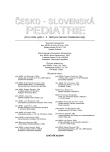Heart Rate Variability in Neonatal Period
Authors:
Z. Lehotská 1; K. Javorka 2; M. Javorka 2; M. Zibolen 1; S. Krupičková 3
Authors‘ workplace:
Neonatologická klinika, Jesseniova lekárska fakulta Univerzity Komenského
; a Martinská fakultná nemocnica, Martin
prednosta prof. MUDr. M. Zibolen, CSc.
1; Ústav fyziológie, Jesseniova lekárska fakulta Univerzity Komenského, Martin
vedúci prof. MUDr. K. Javorka, DrSc.
Klinika detí a dorastu, Jesseniova lekárska fakulta Univerzity Komenského
2; a Martinská fakultná nemocnica, Martin
prednosta prof. MUDr. P. Bánovčin, CSc.
3
Published in:
Čes-slov Pediat 2007; 62 (2): 98-104.
Category:
Review
Overview
The evaluation of heart rate variability (HRV) is often used for examination of regulation/dysregulation of heart functions and detection of pathological changes of autonomous nervous system. In neonatal period, authors have to regard specific conditions in examination and evaluation of obtained records. The heart rate variability is markedly influenced by age of the patient. The clinical application of this method is dependent on establishment of physiological values for certain age group. The breathing pattern affects markedly the high frequency band (HF). High breathing rate of newborns (40–60 per minute) reflects above the HF wave-length specified for adults. So, it is necessary to elect different type of evaluation and shift the upper limit of HF band to 1 Hz (the neonatal version). The position during examination is important input affecting the activity of regulation systems and variability of cardiovascular parameters of children and adults.
Authors prefere supine position for examination in neonatology. HRV changes in dependence of sleep stage or alertness. Theese changes are relative to physiological parasympathetic prevalence and type of respiration during sleep. Neonatology is a big challenge for clinical application of HRV examination. They have to accept different conditions of examination, postnatal adjustment of cardiovascular system to extrauterine life and continuing development of autonomous nervous system. The knowledge of physiological changes of HRV may contribute to application of this method in specific pathological conditions.
Key words:
heart rate variability, newborns, respiratory sinus arhytmia, autonomic nervous system
Labels
Neonatology Paediatrics General practitioner for children and adolescentsArticle was published in
Czech-Slovak Pediatrics

2007 Issue 2
Most read in this issue
- Multiple Intracranial Complications of Pansinusitis in Children
- Continual Monitoring of Electric Brain Activity in Newborns (aEEG – Amplitude Integrated EEG)
- Bone Marrow Transplantation in Children – Parents’ Point of View
- Teratogenic Phenylketonuria-related Embryopathy
